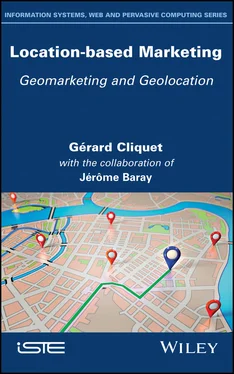Another economist (and also a leading statistician), Hotelling (Hotelling 1929), described in a celebrated article the consequences of location changes using a simple example and thus defined the principle of minimal differentiation, often referred to as the Hotelling rule (Martimort et al . 2018) or the Hotelling law (Russell 2013). Hotelling developed the idea that competition between producers tends to reduce the difference between their products. His theory is still being discussed today and is still the basis for much research. It has thus been possible to demonstrate in a theoretical way the contribution of advertising in order to allow companies to bypass this principle of minimal differentiation (Bloch and Manceau 1999). Geographers then developed the concept of central squares (Christaller 1933) from which the hierarchy of cities and the hexagonal shape of the geographical segments surrounding the squares (cities, towns, villages) were deduced (see Figure 1.1).
Each economic actor maximizes its utility (consumer) or its profit (firm) in a homogeneous space where prices are fixed and where the cost of transport depends on distance. The hexagonal shape of Figure 1.1theoretically facilitates a perfect interlocking of these segments around the squares that form a network as shown in southern Germany (Christaller 1933), southwestern Iowa, northeastern South Dakota and the Rapid City area of the United States (Berry 1967). In these great plains of the United States, a diamond-shaped network of central squares was observed; this is called a rhomboidal grid. This network of markets, with regular hexagonal outlines, suggests, on the one hand, the existence of a single equilibrium configuration with a given number of firms on the market, and on the other hand, the domination of this network with free market entry (Lösch 1941). This author formalizes the central place theory using a micro-economic approach. It is also based on the actual price of a good defined from its factory price plus the cost of transport. As the latter increases with distance, the quantity requested will be reduced accordingly, thus allowing the construction of space demand cones by integrating the function linking quantities requested, on the one hand, and price and distance in transport costs, on the other hand. Lösch then defines a profitable location as one whose sales amount, as determined by the spatial demand cone, provides the appropriate rate of return. This concept would correspond well to the markets for industrial goods (Böventer 1962). This design will be challenged, because this hexagonal network is not the only equilibrium configuration (see above the rhomboidal grid) and free market entry does not necessarily lead to hexagonal shapes of market segments (Eaton and Lipsey 1976). In any case, it is possible to retain from this work the idea of centrality with the objective of reducing distance for the greatest number of people and thus facilitating access to goods and services.

Figure 1.1. Theoretical and schematic representation of central place theory
(source: after (Christaller 1933))
Shortly before, another geographer (Reilly 1931), a consultant to his state, had proposed a law of retail gravitation, often called Reilly’s law, based on the notion of gravitation by analogy with Newton's theory applied here to retail activities. This law was for a long time the basis for many academic and professional projects, for example to set up supermarkets in rural areas or malls. Based on this pioneering work, researchers have proposed models to better understand consumer spatial behavior and, above all, to predict the future level of city activity or store sales (Converse 1949; Huff 1964; White 1971) until these attraction models become widespread, whether spatial or not (Nakanishi and Cooper 1974).
Pioneering work in space marketing as early as the 1970s and based on time series data, long before geomarketing software appeared, showed that it was important to study market shares according to sales territories in order to understand how buyers react and to better predict these sales (Wittink 1977). It can be concluded that advertising, which is supposed to increase sales if adapted to the territories, can improve price sensitivity.
However, a few years later, based on previous work (Ohlin 1931), it became apparent that marketing researchers were not interested in spatial or regional issues (Grether 1983). It could not be said today that much has changed. Even store location issues are no longer of much interest to researchers, probably because it is mistakenly believed that the Internet has definitively removed the tyranny of distance. However, most of the pure players, those businesses that are only present on the Internet, are starting to open brick and mortar stores that are either physical or “hard”: Amazon has acquired the Whole Foods Market network of organic stores in the United States.
Moreover, the very rapid development of applications (apps) on smartphones may change the situation by creating on the one hand a real mobile commerce and on the other hand a new kind of spatial consumer behavior favoring mobility (or rather ubiquity), comparisons of products, services, prices, etc.
1.2.2. Definition of spatial marketing and geomarketing
Spatial marketing is a broader and more conceptual field than geomarketing, which remains more oriented towards mapping techniques.
1.2.2.1. Definition of spatial marketing
Spatial marketing can be defined as anything related to the introduction of space into marketing from a conceptual, methodological and of course strategic point of view (Cliquet 2006, 2003). This implies taking into account not only issues related to the local or regional environment at the microeconomic level (Grether 1983), but also in relation to territorial coverage in the geographical sense. This concept does not necessarily imply that territories correspond to political division and/or interculturality at a more socio-cultural scale at the macroeconomic level, in other words in relation to national and international frameworks (Ohlin 1931; Hofstede et al . 2002).
The many issues developed in this book concern not only marketing in the strict sense of the term, but also other management disciplines such as information systems management and human resources, strategy, logistics, organization at local, regional, national or international level. Spatial marketing is useful in the management of organizations insofar as it makes it possible to specify and strengthen proximity with the customer and therefore customer relations depending on where the customer is located. It authorizes the link between this geolocation and the customer’s personal data. The verb “authorize” is used intentionally, because the risk of breaking the boundaries of individual privacy is real; it is an important societal issue as is the installation of video cameras in public places for security reasons. Surveys on personal data protection (privacy) show that consumers are aware of possible abuses, but this does not prevent them from using smartphones and tablets (Cliquet et al . 2018), and the Absher application that Saudi Arabian men use to track their wives does not help.
1.2.2.2. Definition of geomarketing
Geomarketing is based on digital geography using computer science, that is, computerized cartography and therefore geography on the one hand and marketing on the other. It is a term coined in France by practitioners in the 1980s. Strangely enough, this word is almost unknown in North America 30 years later. On the other hand, we hear about micro-marketing, geodemographics, GIS or Location Business Intelligence in the United States, even though people are familiar with geomarketing in Quebec. It has subsequently spread to the European continent: there is research on the openly displayed theme of geomarketing in Belgium (Gijsbrechts et al . 2003), and above all specialized works, often short and technical, for example in Germany (Schüssler 2006; Tapper 2006; Grasekamp et al . 2007; Herter and Mühlbauer 2007; Trespe 2007; Menne 2009; Kehl 2010; Kroll 2010), Spain (Chasco and Fernandez-Avilez 2009; Alcaide et al . 2012) and Italy (Galante and Preda 2009; Cardinali 2010; Amaduzzi 2011). In France, there are books by consultants that generally present, in a clear manner, the possibilities offered by their firm (Marzloff and Bellanger 1996; Latour 2001) and academic books either oriented towards business studies (Douard 2002; Douard and Heitz 2004) or methodology (Barabel et al . 2010) or concept and strategy (Cliquet 2006). Some books on digital geography also deal with geomarketing (Miller et al . 2010).
Читать дальше













